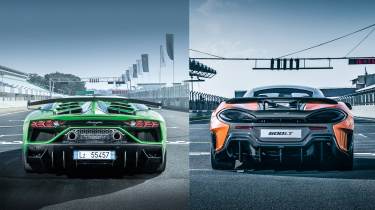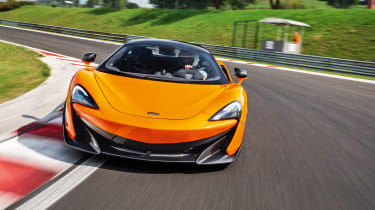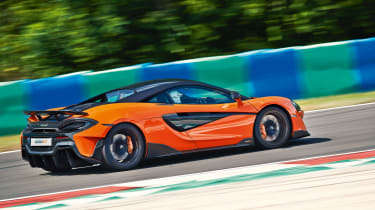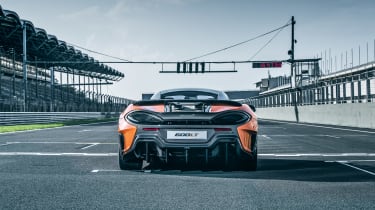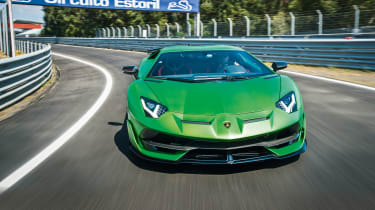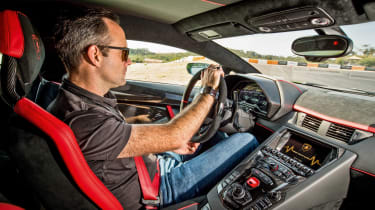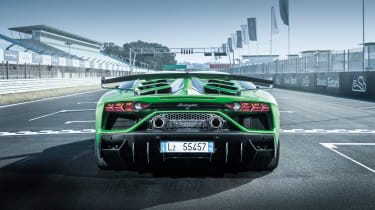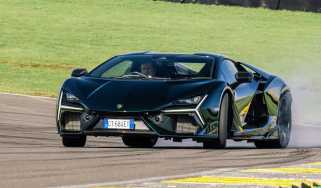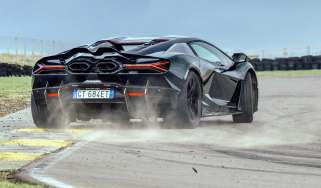Lamborghini Aventador SVJ vs McLaren 600LT - hardcore track coupes compared
McLaren has its most hardcore Sports Series model yet in the 592bhp 600LT, while Lamborghini has launched its hottest Aventador to date with the 759bhp SVJ. Time to find out what they’re made of…
It was a tour of hired racing circuits for evo back in Summer 2018. First came the McLaren Senna, launched with track driving at Silverstone and then at Estoril in Portugal, and then it was the turn of the 600LT at the thrilling Hungaroring, again with track driving only for this first encounter. Then, in short order, it was back to Estorial for another track event to drive the new Lamborghini Aventador SVJ, which, you guessed it, also precluded any road driving.
I won’t lie, that’s frustrating in some senses for us, because given these cars wear number plates it’s inconclusive to only consider them from purely a circuit-driving perspective, even if their performance means that, realistically, this is the only environment where you can experience them to the full. But what a pair they are – McLaren’s first hardcore Sports Series model, and what just might turn out to be the ultimate naturally aspirated V12 Lamborghini ever made.
> McLaren 600LT review – latest Longtail model set to take the fight to Porsche’s RSs
McLaren 600LT, Hungaroring
To Hungary first, then, where the McLaren new-product colossus continued its relentless output. The 600LT follows in the substantial tyre tracks of the fabulous Super Series 675LT, as McLaren pushes hard to establish the Longtail sub-brand as its own ‘RS’ department.
We first saw the ultimate Sports Series model in a static reveal earlier in the year, and if its stats were unequivocally enticing, then so was there just the fleeting thought in my mind that it could be a derivative too far. Don’t get me wrong, given its core ingredients it was bound to be a really good car, but McLaren’s commonality of fundamental parts and an already burgeoning range of supercars had me worried that the 600LT might struggle to find the clear air where it could wear the LT moniker comfortably, even if the blue flame from its top-mounted exhaust was an instant social media hit.
Yet from the moment I begin to listen to the LT’s senior engineering team talk about the car, their passion for creating a machine for those who really care about driving, and their obsessive attention to every last detail, mean any misgivings are replaced by an itch in my palms to grasp its Alcantara wheel immediately and go for it out on the circuit.
To recap, the 600LT isn’t about raw power, although that does sound absurd when you consider that it boasts 592bhp from the usual 3.8-litre twin-turbo V8, up from 562bhp in the 570-series models. The power increase is down to a remap and that rather special exhaust, but perhaps more noteworthy is the 84kg reduction in kerb weight, to 1356kg, compared with a 570S (or 88kg if you spec the optional carbon front wings and roof). Weight has been saved throughout the car, whether that’s substantially in the form of 21kg from ditching the standard 570 seats, or a single kilo from deleting the glovebox and door pockets.
In fact, 23 per cent of the parts make-up has changed from the 570S, the Longtail moniker justified to the letter by a 47mm extension to the car’s rear, which is complemented by a 27mm longer splitter at the front. The increased manipulation of air means there’s now 100kg of downforce at 155mph, compared to the neutral figure of the regular car, but with no penalty in terms of drag, while under the carbonfibre skin you’ll discover new forged alloy wishbones, stiffer and hollow anti-roll bars, recalibrated dampers and the carbon-ceramic braking set-up from a 720S along with a Senna-inspired brake booster. Furthermore, the steering rack has a four per cent quicker ratio, there are stiffer mounts for the engine and transmission, and the 19-inch front and 20-inch rear wheels are wrapped in a new, bespoke Pirelli Trofeo R tyre.
From the very first moment I turn the 600’s wheel in the pitlane, it just feels so right. That might sound puerile, but the additional weight, the response immediately off-centre and the progressiveness of it overshadow what in the 570S was already a fine example of a hydraulically assisted set-up.
In fact, earlier I’d grabbed a few laps in a 570 to try to learn the circuit, and fast and fun it was too (the car and the track). But as impressive as a car like the 570S is, there’s still a thin, glossy layer of varnish on top of everything that it does, a buffer, if you like, to make it undemanding for the broad customer base it’s aimed at. The 600LT takes those core attributes and pours over a tin of industrial paint stripper, burning through the surface until the real car is revealed underneath. Where the 570 when hard pressed introduces just the merest hint of vagueness, of squidge and imprecision, everything the 600LT does is ruthlessly, but delightfully, transparent and true.
There is immense speed here on offer – 0-62mph takes 2.9sec; 0-124mph just 8.2. For reference the 675LT takes an identical 2.9sec and a barely distinguishable 7.9sec for the same benchmarks. But somehow that pace seems a given. In Track mode the ‘inertia push’ gearchange is so quick that it’s hard to even register mentally, but it’s when you come off the power that the 600LT gets truly engrossing.
The braking ability is formidable, but it’s the resistance of the pedal that I really admire, and it’s this carefully controlled weightiness – not to be confused with stodginess – to the response that’s replicated throughout all the main controls; a polished uniformity, so often associated with the best Porsches, that means within half a lap I have to refocus my mind on specific elements of the car’s behaviour so as to be able to write this story, otherwise I’d simply be having a ball and thinking about how I could make the thing go quicker, completely accepting of how the 600LT goes about its work.
The 600LT, on track at least, is that sort of car. The Hungaroring serves up a particularly tasty menu of corners, gradients and straights, and the car’s stability under braking, even when the ABS is triggered over a kerb, is exemplary, it’s adjustability on the throttle mid-corner as deft as you can manipulate with your right foot. All of which makes this car somehow unthreatening – up to a point, at least – and because it asks less mentally and physically than a car such as the Senna, while the lap times might be slower, there’s a strong case to say it’s more enjoyable. It is a bind, to say the least, when my laps are used up, for I’d happily lap around here until the fuel tank ran dry.
Priced somewhere between 911s GT3 RS and GT2 RS, the 600LT commands a new middleweight niche, but even against cars from the class above, on this first acquaintance, it should fear none of them. Oh, and did I mention it spits blue flames out of the high-mounted exhausts?
Lamborghini Aventador SVJ, Circuito do Estoril
Across to Portugal and the Circuito do Estoril, where a fortnight previously the circuit was, at no doubt frightening expense, completely resurfaced with flawless virginal black asphalt. ‘Perfect’, you might think, but the Lamborghini people are aghast when we arrive, for the track now offers all the adhesion of a freshly mopped supermarket floor, the situation compounded by Lambo’s decision to leave the Trofeo tyres at home due to fears over their wear rate on the old surface. The result, when you try to lean on the SVJ in the corners, is comedic howls of protest from rubber that shows no sign of wear even after multiple stints on the track. Mamma mia.
Our 4WD megatest in winter 2017 proved beyond doubt that the Aventador is a car that likes to get its bodywork dirty and have a good time. There’s a proper driver’s car beneath all that inner-city supercar-spotting nonsense, and the fact that the SVJ has got one over on the formidable GT2 RS at the Ring suggests something rather special must be going on to make a venerable Aventador travel that quickly through the Eifel Forest.
> Lamborghini Aventador SVJ review - V12 power and tech turns in a mighty performance
The answer lies with a group of initialisms tied into a larger, central initialism, but first, something that’s easier to understand: power. The actual output of the SVJ’s V12 seems increasingly unimportant beyond knowing that it has ‘enough’. What really does matter is that it’s a flipping great big 6.5-litre, naturally aspirated V12, with a deliciously crisp response to the throttle and a soundtrack that intrinsically elevates one’s soul. ‘A V12 ees the best singer,’ says engineering chief Maurizio Reggiani, at which point it’s physically impossible not to smile.
Still, 759bhp at 8500rpm are still very much numbers worthy of study, and while 531b ft at 6750rpm suggests a classically peaky delivery, the torque graph illustrates there’s a meatier deployment of mid-range pull over the old Aventador SV (740bhp, 509lb ft). This is because the SVJ V12’s induction system and cylinder heads are new, with titanium intake valves for the first time, while there’s also a new, shorter exhaust and a lighter flywheel. The V12 wasn’t exactly lethargic before, but it now promises to be utterly feral.
Gearbox? Naturally that’s still the old single-clutch automated unit with, yes, it’s boisterous shifts in Corsa mode and its low-speed clumsiness. Brakes? Massive 400mm front, 380mm rear carbon-ceramic discs, so they should be fine, despite the SVJ not being an especially light car. Incidentally, the kerb weight – 1525kg dry – is the same as quoted for the old SV; the additional use of carbonfibre inside and out, along with new lightweight centrelock wheels, has offset the weight gain from incorporating a lot of new tech.
The highlight of this new technology is the incorporation of Aerodinamica Lamborghini Attiva (ALA), the active aerodynamics set-up first seen on the Huracán Performante, and now in 2.0 form. The brief version is that, with the system’s intakes closed, the front splitter and rear wing work as normal, and they’re much more effective than the SV’s, offering 40 per cent more downforce. However, when the car is running at speed in a straight line, ALA operates like a form of DRS, opening flaps to reduce the pressure on the front splitter and ‘stall’ the rear wing, greatly reducing aerodynamic drag. Moreover, both left and right sides of the wing can be ‘on’ or ‘off’ independently, applying downforce to the inside of the car when turning into a corner.
This is the clever bit; the SVJ’s secret. All of the hard work has been in exploiting ALA 2.0 along with other systems via the central LDVA ‘brain’ (that’s Lamborghini Dinamica Veicolo Attiva – active vehicle dynamics). The S model’s rear-wheel steering is retained but recalibrated, along with a little more rear bias for the four-wheel drive, while the Dynamic Steering system, with as little as 2.1 turns lock-to-lock, now has its ratio frozen in the Corsa and Ego modes. There are stiffer anti-roll bars and recalibrated, more resilient dampers, although the spring rates are the same. Crucially, there are bespoke Pirellis too: P Zero Corsas and, for the first time on the big car, a Trofeo R. Everything about the SVJ has been carefully honed to get you in, through and out of a corner as fast as possible.
As I approach ‘my’ SVJ in the pitlane the combined decibels of the idling V12 and the fans heroically struggling to keep it cool in 30deg C heat make me chuckle. Even at a standstill this great slab of old-school supercar is hugely intimidating. Up goes the scissor door, and as I sink into the hard bucket seat I’m reminded of how it really belongs in the Tower of London as an example of medieval brutality, how there’s precious little headroom if you sit normally, how for such a big car it’s fairly claustrophobic in here. And while forward vision is massively obscured by those girders for A-pillars, it’s now almost non-existent aft with the ALA ducting.
Over the start line at full pelt, SVJ in the angriest Corsa setting, and my inner ear feels as though it’s being pummelled to destruction by the sonic waves emanating from behind the bulkhead. Braking from over 160mph the middle pedal feels softer than a 600LT’s, but the speed is wiped off convincingly and actual feel underfoot is good, helped by the centre clutch disengaging under braking for the first time. I can sense a slight yaw movement under such force, a delicate reminder that a very, very large V12 engine resides over my shoulder, but it’s not frightening, just nicely informative.
The moment I turn the wheel the agility of the SVJ is obvious. Yes, it has nothing like the turn-in I suspect it possesses on grippy tarmac with Trofeos, but still, the nose turns quickly enough that I make a mental note to keep my inputs as small and accurate as possible. There’s real feel through the steering too, and a keen sense that the car is being pulled straight at the exit. A blast of revs in second, then protest from the outer front and understeer into Turn 2 (blame the surface) before a big stop into the uphill hairpin of Turn 3. I try upshifting mid-corner a few corners on, but the pause and clonk of a part-throttle shift has the SVJ’s nose shifting the trajectory by a couple of feet, so I won’t be doing that again.
Thundering down the back straight the SVJ feels properly quick, but it’s easy enough to pick a braking point then guide the chiselled nose into the apex as you bleed the pressure off, and playing with the throttle reveals a keenly adjustable response. The more – and harder – I drive the SVJ, the more accommodating it feels. Yes, there’s still a layer of ESP left in place, but then it was for its 6:44.97 Ring time too, and unless you’re clumsy you’re not aware of any intervention. I’ve no doubt that a loss of adhesion at high speed will still be a very senior moment indeed in an SVJ, but its behaviour in slow- and medium-speed corners makes it very exploitable.
Embarrassing track-related lack of grip aside, the SVJ feels a significant step on from the SV. It’s a car I want to go faster in, to learn more about its habits and to use to work on my own weaknesses. That enthralling interactivity is something it shares with the 600LT. Clearly, there’s life left in the old bull yet.
| McLaren 600LT | Lamborghini Aventador SV | |
| Engine | V8, 3799cc, twin-turbo | V12, 6498cc |
| Power | 592bhp @ 7500rpm | 759bhp @ 8500rpm |
| Torque | 457lb ft @ 5500-6500rpm | 531lb ft @ 6750rpm |
| Transmission | Seven-speed dual-clutch, rear-wheel drive, open differential | Seven-speed single-clutch automated manual, four-wheel drive, limited-slip differential |
| Front suspension | Double wishbones, coil springs, adaptive dampers, anti-roll bar | Double wishbones, coil springs, magnetic dampers, anti-roll bar |
| Rear suspension | Double wishbones, coil springs, adaptive dampers, anti-roll bar | Double wishbones, coil springs, magnetic dampers, anti-roll bar |
| Brakes | Carbon-ceramic discs, 390mm front, 380mm rear | Carbon-ceramic discs, 400mm front, 380mm rear |
| Wheels | 8 x 19in front, 11 x 20in rear | 9 x 20in front, 13 x 21in rear |
| Tyres | 225/35 R19 front, 285/35 R20 rear | 255/30 ZR20 front, 355/25 ZR21 rear |
| Weight | 1356kg | (dry) 1525kg |
| Power-to-weight | 444bhp/ton | (dry) 506bhp/ton |
| 0-62mph | 2.9sec | 2.8sec |
| Top speed | 204mph | 218mph |
| Basic price | £185,500 | £350,000 |

